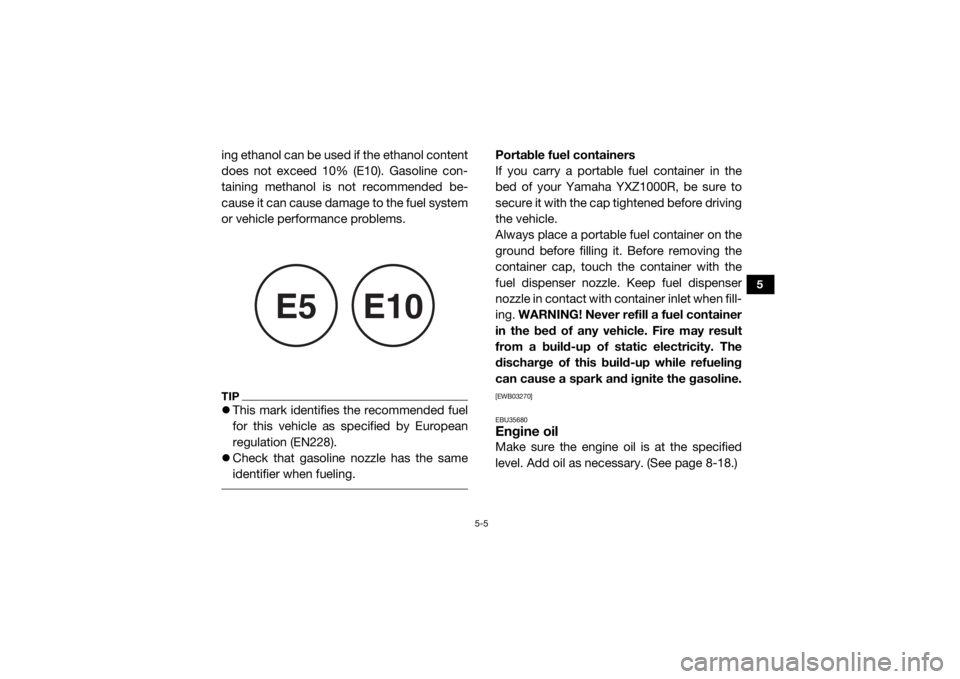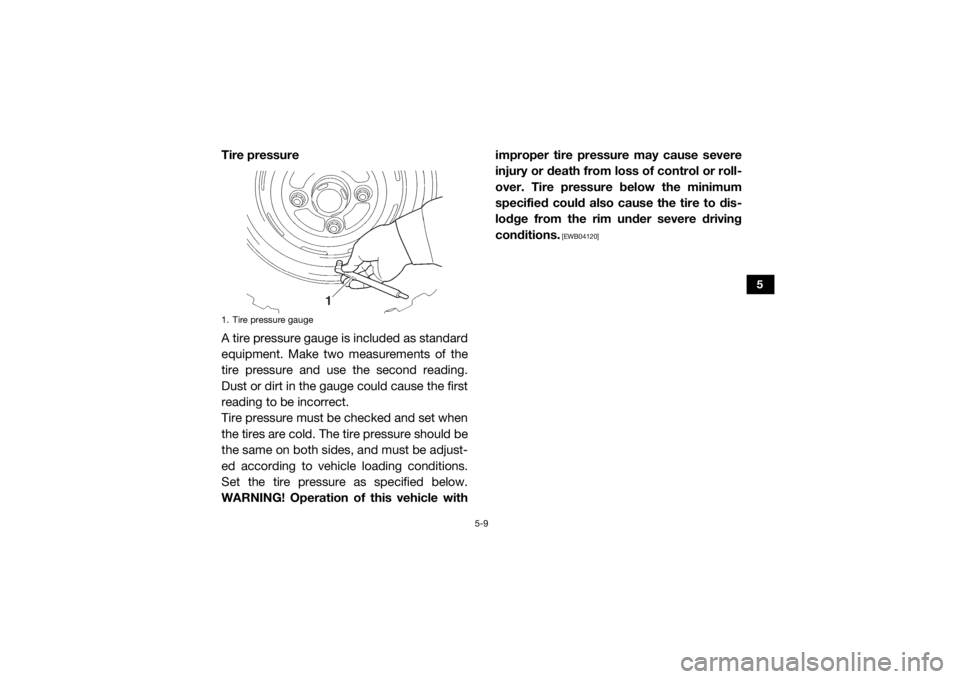YAMAHA YXZ1000R SS 2019 Owners Manual
Manufacturer: YAMAHA, Model Year: 2019, Model line: YXZ1000R SS, Model: YAMAHA YXZ1000R SS 2019Pages: 218, PDF Size: 9.48 MB
Page 91 of 218

5-5
5
ing ethanol can be used if the ethanol content
does not exceed 10% (E10). Gasoline con-
taining methanol is not recommended be-
cause it can cause damage to the fuel system
or vehicle performance problems.TIPThis mark identifies the recommended fuel
for this vehicle as specified by European
regulation (EN228).
Check that gasoline nozzle has the same
identifier when fueling.
Portable fuel containers
If you carry a portable fuel container in the
bed of your Yamaha YXZ1000R, be sure to
secure it with the cap tightened before driving
the vehicle.
Always place a portable fuel container on the
ground before filling it. Before removing the
container cap, touch the container with the
fuel dispenser nozzle. Keep fuel dispenser
nozzle in contact with container inlet when fill-
ing. WARNING! Never refill a fuel container
in the bed of any vehicle. Fire may result
from a build-up of static electricity. The
discharge of this build-up while refueling
can cause a spark and ignite the gasoline.[EWB03270]
EBU35680Engine oilMake sure the engine oil is at the specified
level. Add oil as necessary. (See page 8-18.)
E5
E10
UB5H7AE0.book Page 5 Wednesday, July 4, 2018 1:37 PM
Page 92 of 218

5-6
5
NOTICEECB03020Do not use oils with a diesel specifica-
tion of “CD” or oils of a higher quality
than specified. In addition, do not use
oils labeled “ENERGY CONSERVING II”
or higher.
Make sure that no foreign material en-
ters the oil tank. EBU35322TransmissionMake sure there is no oil leaking from the
transmission case.EBU31761CoolantCheck the coolant level in the reservoir and
replenish if necessary. (See page 8-36.)
EBU36020Final gearMake sure there is no oil leaking from the final
gear case.EBU36030Differential gearMake sure there is no oil leaking from the dif-
ferential gear case.EBU31791Accelerator pedalBefore starting the engine, confirm that the
accelerator pedal operates correctly. It
should depress smoothly and spring back to
the idle position when released. Also check
the accelerator pedal for excessive free play.
If the accelerator pedal is not in correct work-
ing order, have the vehicle inspected before
starting off.
Recommended engine oil type and quantity:
See page 10-1.
UB5H7AE0.book Page 6 Wednesday, July 4, 2018 1:37 PM
Page 93 of 218

5-7
5
EBU31800Seat beltsMake sure that the seat belts are not frayed,
torn, stretched, or damaged. The seat belts
must move smoothly when pulled out and re-
tract on its own when released. The seat belts
must also lock up when quickly pulled out.
The latch plate should click securely into the
buckle and release when the release button is
pushed firmly. Wash off any dirt or mud that
could affect operation. Have a Yamaha dealer
repair as necessary for proper operation.
A crash can damage the restraint systems in
your vehicle. A damaged restraint system
may not properly protect the person using it,
resulting in serious injury or death in a crash.
To help make sure your restraint systems are
working properly after a crash, have them in-
spected and any necessary replacements
made as soon as possible.
EBU31810Passenger handholdCheck that the handhold bar and its supports
are in good condition. Confirm that the lock-
ing pins are securely fastened, and then push
and pull on the handhold to make sure that it
is not loose.EBU31820SteeringPark on level ground. Turn the steering wheel
right and left. Check for excessive free play,
abnormal noises, or a rough feeling. Have a
Yamaha dealer repair as necessary for proper operation.EBU36691Drive select lever and shift paddlesThe drive select lever and shift paddles
should move smoothly and return to their
original position.
UB5H7AE0.book Page 7 Wednesday, July 4, 2018 1:37 PM
Page 94 of 218

5-8
5
EBU36672YCC-S clutchCheck the YCC-S clutch fluid level and cor-
rect if necessary. (See page 8-48.)
Check the operation of the drive select lever
and shift paddles at the start of each drive.TIPIf the YCC-S clutch fluid level was low, be
sure to check the clutch system for leak-
age.
If any leakage is found, or if shifting is not
smooth, have a Yamaha dealer service the
vehicle. EBU35700Fittings and fastenersAlways check the tightness of chassis and
wheel fittings and fasteners before starting
off. Take the vehicle to a Yamaha dealer or re-
fer to the Service Manual for correct tighten-
ing torque.
EBU31840Instruments, lights and switchesCheck that all instruments, lights and switch-
es are working properly. Correct if necessary.EBU31851Control cablesWhen driving in cold weather, always make
sure all control cables work smoothly before
starting off. WARNING! Control cables can
freeze in cold weather and you could be
unable to control the vehicle.
[EWB03280]
EBU37892
TiresCheck and adjust the tire pressure before
each ride. Check tires for wear and damage.
UB5H7AE0.book Page 8 Wednesday, July 4, 2018 1:37 PM
Page 95 of 218

5-9
5
Tire pressure
A tire pressure gauge is included as standard
equipment. Make two measurements of the
tire pressure and use the second reading.
Dust or dirt in the gauge could cause the first
reading to be incorrect.
Tire pressure must be checked and set when
the tires are cold. The tire pressure should be
the same on both sides, and must be adjust-
ed according to vehicle loading conditions.
Set the tire pressure as specified below.
WARNING! Operation of this vehicle with improper tire pressure may cause severe
injury or death from loss of control or roll-
over. Tire pressure below the minimum
specified could also cause the tire to dis-
lodge from the rim under severe driving
conditions.
[EWB04120]
1. Tire pressure gauge
1
UB5H7AE0.book Page 9 Wednesday, July 4, 2018 1:37 PM
Page 96 of 218

5-10
5
Tire inspection
When the tire tread depth has worn to 3 mm
(0.12 in) replace the tire. If the tire has a nail or
glass fragments in it, or if the sidewall is
cracked, replace the tire.
OPERATING TIRE PRESSURE (cold):VEHICLE LOAD of 0.0–195.0 kg (0–430 lb) FRONT: (Recommended)114.0 kPa (1.140 kgf/cm², 16.5 psi)
REAR: (Recommended) 128.0 kPa (1.280 kgf/cm², 18.5 psi)
Front: (Minimum) 110.0 kPa (1.100 kgf/cm², 16.0 psi)
Rear: (Minimum) 124.0 kPa (1.240 kgf/cm², 18.0 psi)
VEHICLE LOAD of 195.0–336.0 kg (430–
741 lb) FRONT: (Recommended)114.0 kPa (1.140 kgf/cm², 16.5 psi)
REAR: (Recommended) 169.0 kPa (1.690 kgf/cm², 24.5 psi)
Front: (Minimum) 110.0 kPa (1.100 kgf/cm², 16.0 psi)
Rear: (Minimum) 165.0 kPa (1.650 kgf/cm², 24.0 psi)
Vehicle load is total weight of operator, pas-
senger, accessories, cargo, and trailer
tongue weight. Do not exceed maximum
vehicle load of 336.0 kg (741 lb).
1. Tire tread depth
1
UB5H7AE0.book Page 10 Wednesday, July 4, 2018 1:37 PM
Page 97 of 218

6-1
6
EBU31872
OPERATION
EBU31880Read the Owner’s Manual carefully to be-
come familiar with all controls. If there is a
control or function you do not understand,
ask your Yamaha dealer.
WARNING
EWB03290Failure to familiarize yourself with the con-
trols can lead to loss of control, which
could cause an accident or injury. EBU35720Engine break-inThere is never a more important period in the
life of your vehicle than the period between 0
and 20 hours.
For this reason, we ask that you read the fol-
lowing material carefully. Because the engine
is brand new, you must not put an excessive
load on it for the first several hours of opera-
tion. During the first 20 hours, the variousparts in the engine wear and polish them-
selves to achieve the correct operating clear-
ances.
During this period, prolonged full-throttle op-
eration or any condition that might result in
excessive engine heating must be avoided.
However, momentary (2–3 seconds maxi-
mum) full-throttle operation under load does
not harm the engine.
Each full-throttle acceleration sequence
should be followed with a substantial rest pe-
riod for the engine, by cruising at lower r/min
so the engine can rid itself of the temporary
build-up of heat. If any abnormality is noticed
during this period, consult a Yamaha dealer.
0–10 hours:
Avoid prolonged operation above 5300 r/min.
Allow a cooling-off period of 5 to 10 minutes
after every hour of operation. Vary the speed
of the vehicle from time to time. Do not oper-
ate it at one set throttle position.UB5H7AE0.book Page 1 Wednesday, July 4, 2018 1:37 PM
Page 98 of 218

6-2
6
10–20 hours:
Avoid prolonged operation above 6300 r/min.
After break-in:
The vehicle may now be operated normally.EBU36560Starting the engine1. Turn the key to “ ” (on).NOTICEECB03340The coolant temperature warning light,
YCC-S system warning light, and engine
trouble warning light should come on, then
go off.
The EPS warning light should come on,
then go off when the engine is started.
To avoid possible damage, do not operate
the vehicle if a warning light does not work
as described above. 2. Press the brake pedal.
3. Shift the transmission into neutral.
When the transmission is in the neutral
position, the transmission gear display
shows “N” and the neutral indicator
light should come on.
The engine can be started in any gear if
the brake pedal is applied. However, it
is recommended to shift into neutral
before starting the engine.
4. With your foot off the accelerator pedal, start the engine by turning the key to “ ”
(start).
If the engine fails to start, release the key, and
then try starting it again. Wait a few seconds
before the next attempt. Each attempt should
be as short as possible, to preserve battery
energy. NOTICE: Do not crank the engine
more than 5 seconds on each attempt, or
starter damage could occur. Wait at least
5 seconds between each operation of the
electric starter to let it cool.
[ECB02140]
Do not turn the key to the “ ” (start) position
with the engine running; otherwise, damage
to the electric starter may result.
UB5H7AE0.book Page 2 Wednesday, July 4, 2018 1:37 PM
Page 99 of 218

6-3
6
TIPFor maximum engine life, never accelerate
hard when the engine is cold! EBU36723Shifting and reverse drivingThis vehicle is equipped with a 5-speed for-
ward and 1-speed reverse manual transmis-
sion with YCC-S (see page 4-23). The
transmission allows you to control the
amount of power you have available at a giv-
en speed for starting off, accelerating, climb-
ing hills, engine braking, etc.
Shift gears using the drive select lever and the
shift paddles; clutch operation is automatic.
Use the drive select lever to shift the trans-
mission into forward drive (first gear), neutral,
and reverse gear as shown. Use the shift pad-
dles to shift through the forward gears as
shown.
1. Drive select lever
2. Neutral position
1. Shift paddle “ ”
2. Shift paddle “ ”
1
2
2
1
1
2
3
4
5
5
4
3
2
1
UB5H7AE0.book Page 3 Wednesday, July 4, 2018 1:37 PM
Page 100 of 218
![YAMAHA YXZ1000R SS 2019 Owners Manual 6-4
6
TIPTo use the drive select lever, you must be
pressing the brake pedal and be stopped
(be traveling less than 5 km/h [3 mph]), and
the engine should be at idle speed.
You can shift betwee YAMAHA YXZ1000R SS 2019 Owners Manual 6-4
6
TIPTo use the drive select lever, you must be
pressing the brake pedal and be stopped
(be traveling less than 5 km/h [3 mph]), and
the engine should be at idle speed.
You can shift betwee](/img/51/53887/w960_53887-99.png)
6-4
6
TIPTo use the drive select lever, you must be
pressing the brake pedal and be stopped
(be traveling less than 5 km/h [3 mph]), and
the engine should be at idle speed.
You can shift between forward (first gear)
and reverse gear directly - it is not neces-
sary to shift into neutral.
When using the shift paddles, YCC-S may
not complete the upshift if engine or vehicle
speed is too low, nor complete the down-
shift if engine or vehicle speed is too high.
When AUTO DOWNSHIFT is downshifting
gears, do not operate the shift paddles or
accelerator pedal.
During an emergency stop or sudden brak-
ing, AUTO DOWNSHIFT will not downshift
the transmission to first gear. Use the shift
paddle “ ” to downshift, and then apply
the accelerator pedal to resume normal op-
eration.
NOTICEECB03370Even with the transmission in the neutral
position, do not coast for long periods of
time with the engine off. The transmission
is properly lubricated only when the engine
is running. Inadequate lubrication may
damage the transmission. To start out and accelerate
1. Take your foot off the accelerator pedal
and apply the brake pedal. NOTICE: Al-
ways take your foot off the accelerator
pedal before operating the drive select
lever, otherwise damage to the engine
and drivetrain may result.
[ECB03360]
2. Release the parking brake (if applied).
3. Shift into first gear using the drive select lever (the transmission gear display
should show “1”).
4. Release the brake pedal and press the accelerator pedal gradually.
UB5H7AE0.book Page 4 Wednesday, July 4, 2018 1:37 PM